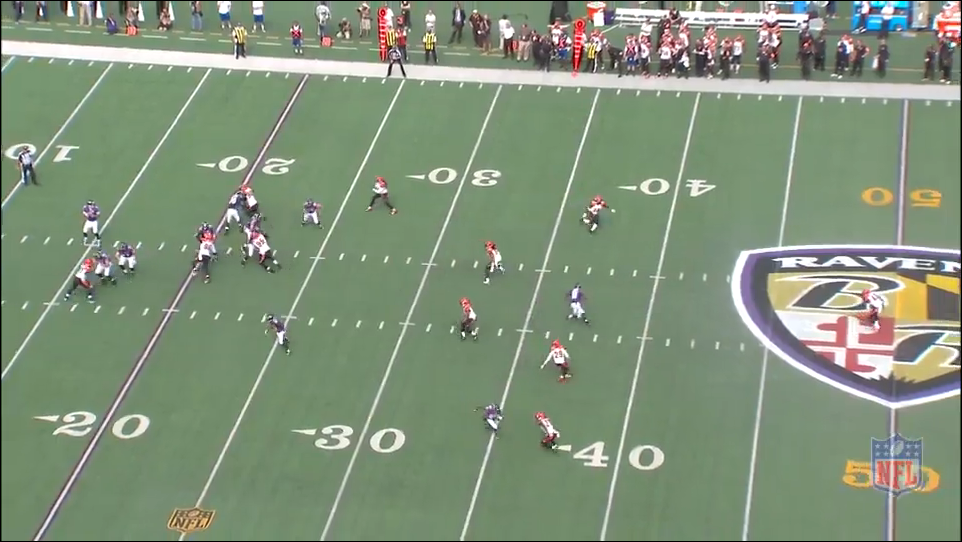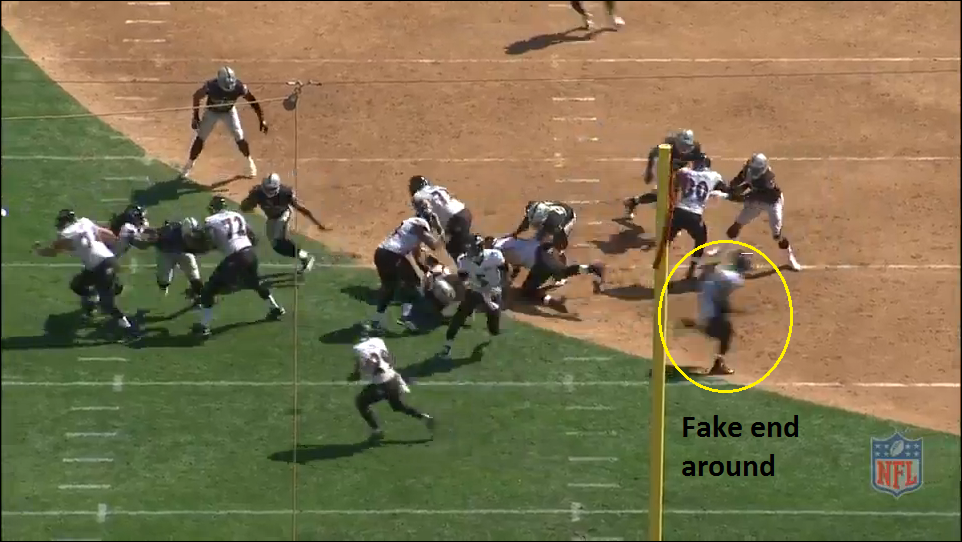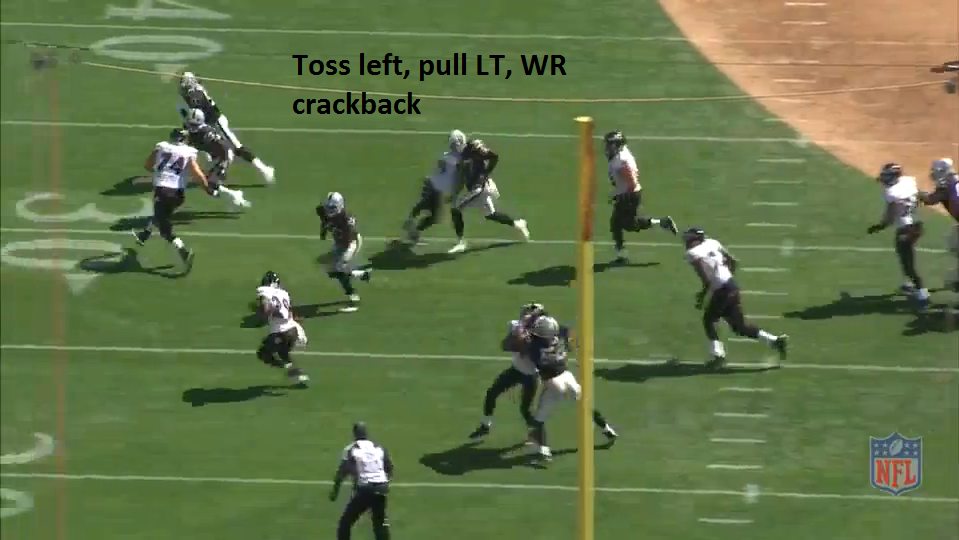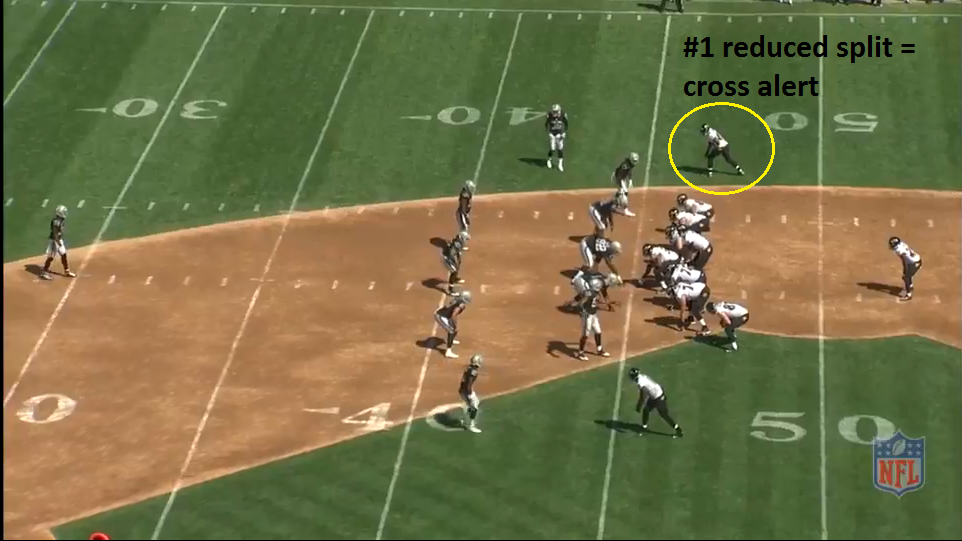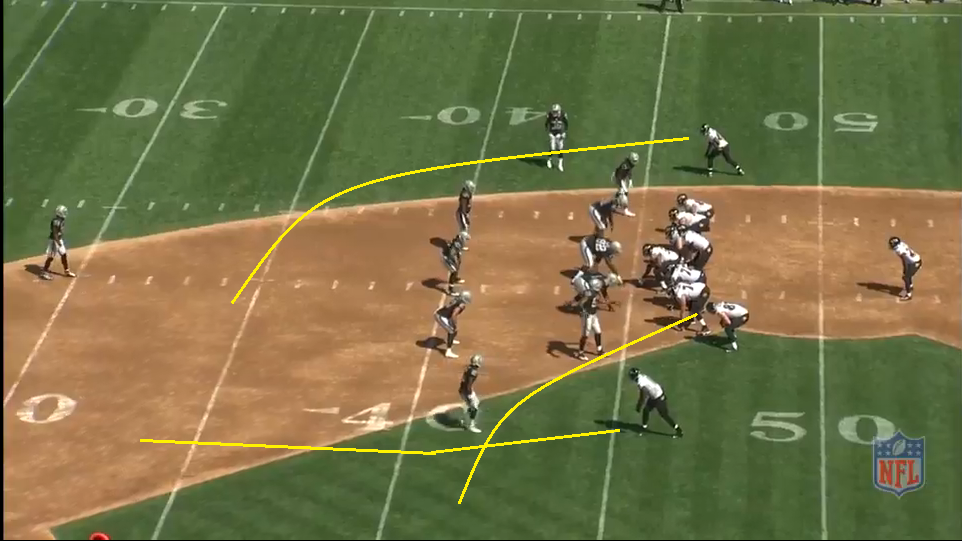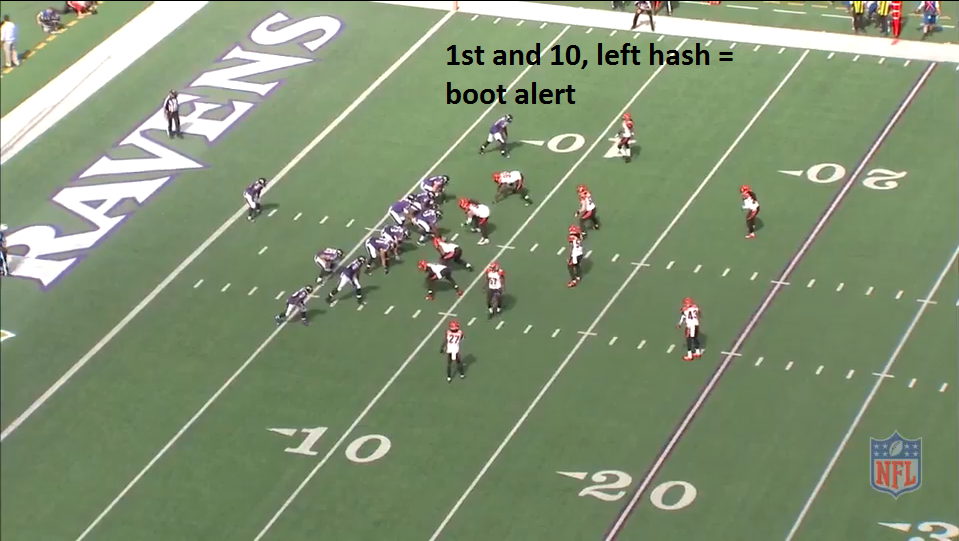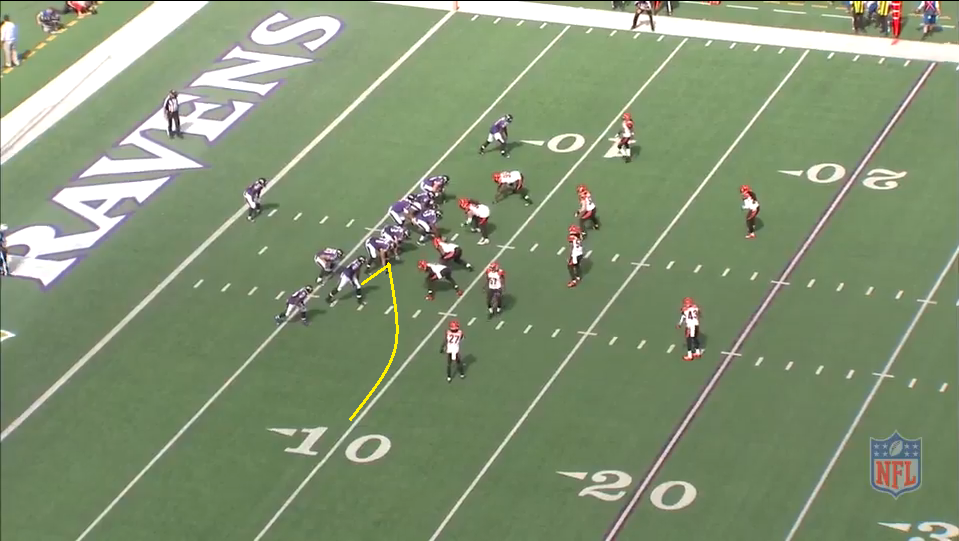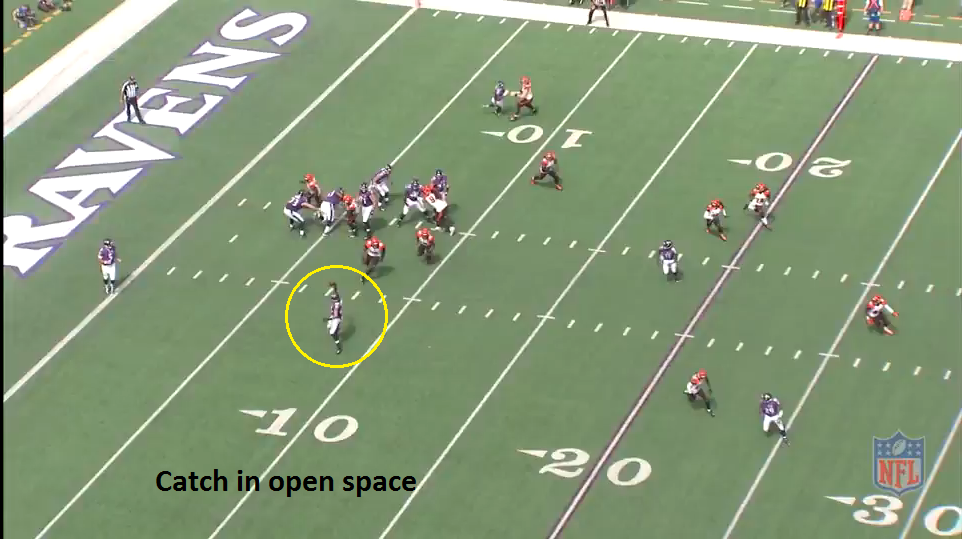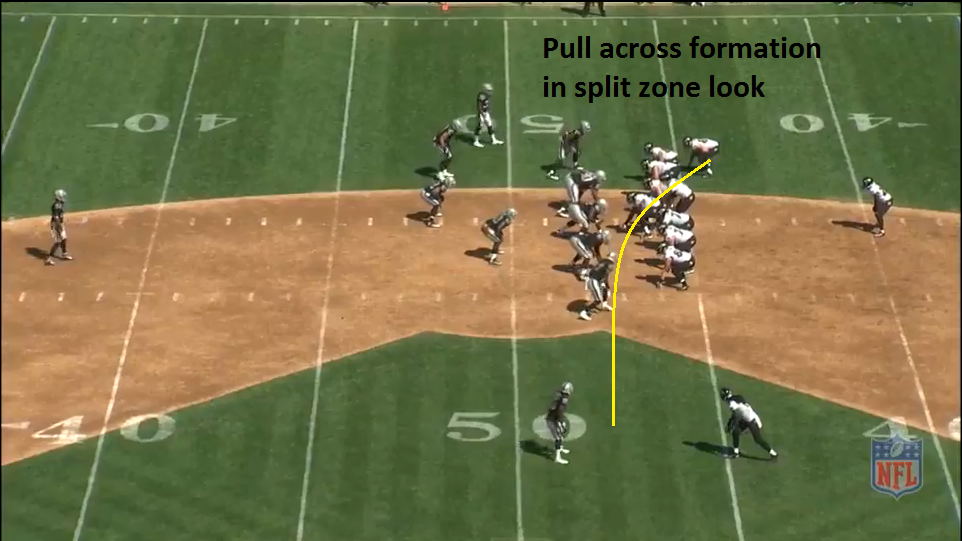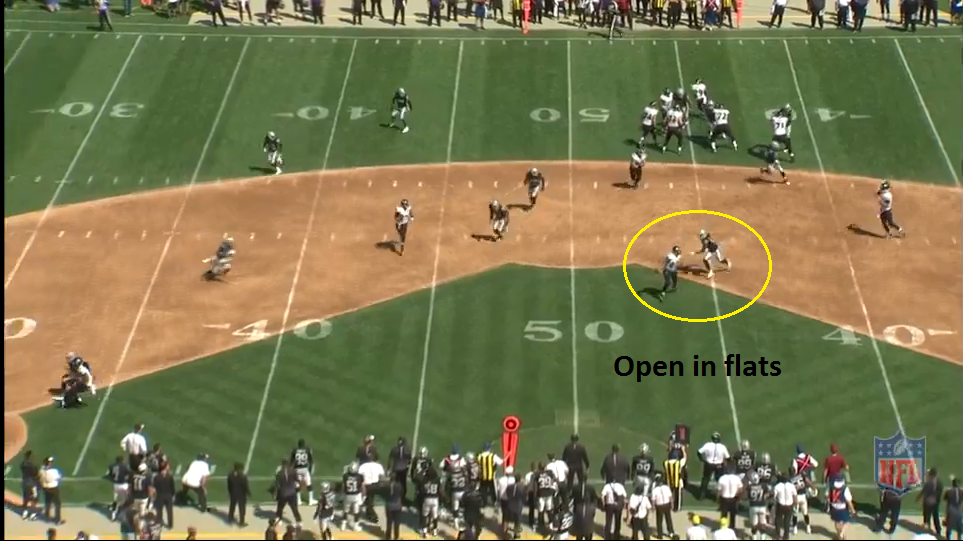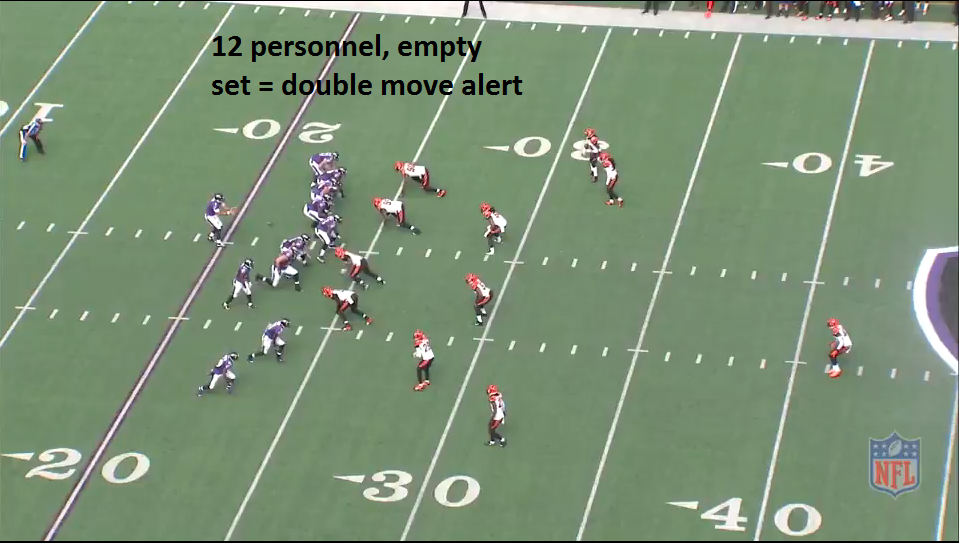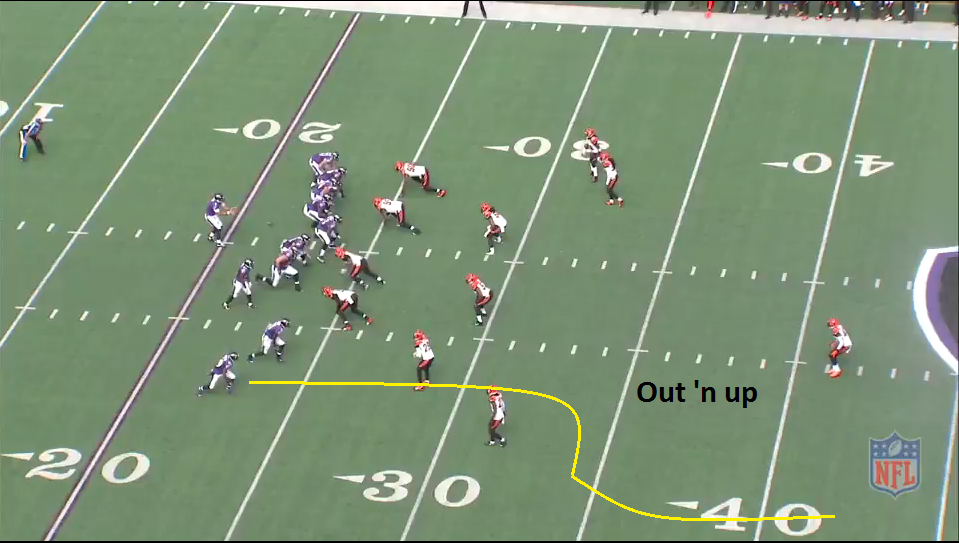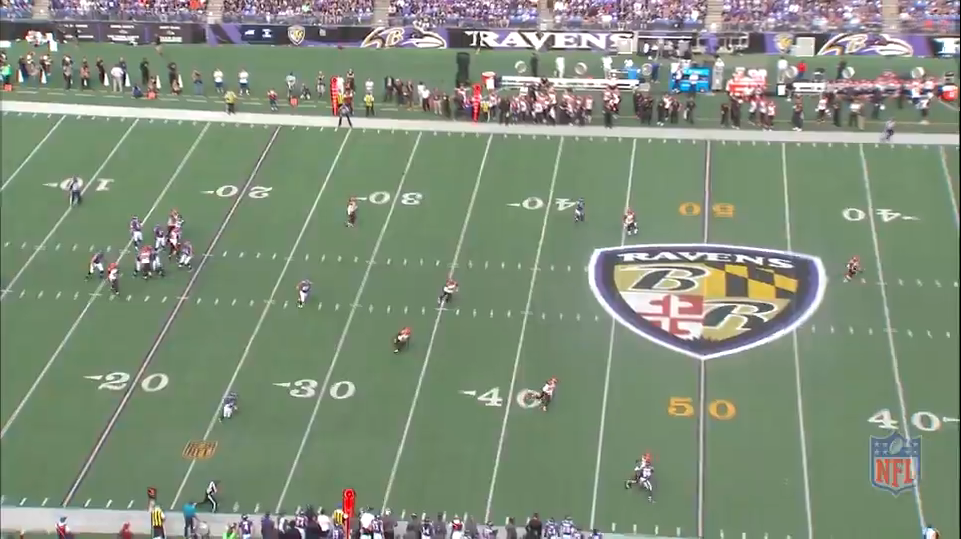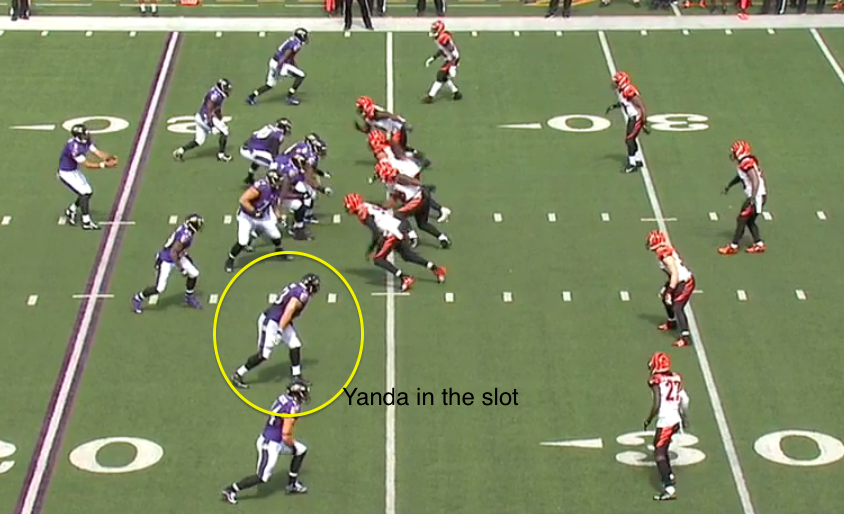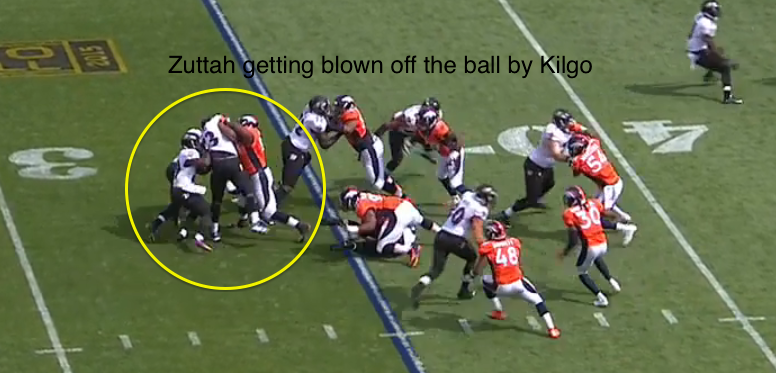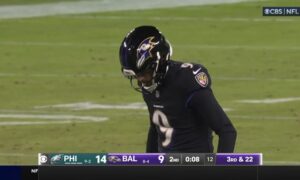This year, Jon Ledyard and I will be collaborating our scouting reports. We’ll play to our strengths – he’ll be focusing on the individuals while I’ll be looking at overall scheme. These reports will be broken down into two articles, one for offense and one for defense.
Our reports for the Baltimore Ravens’ offense.
ALEX’S SCHEME REPORT:
Baltimore’s Run Game
The Ravens’ run game has sputtered in 2015, a stark contrast to its success last year. No longer having Gary Kubiak appears to be a big blow. As a team, they only have four runs of 10+ yards, tied for 28th in the league. Only the Detroit Lions have fewer (2).
Their longest rush is 20, one of only two teams in the league with a number so low.
As Dave Bryan noted the other day, the Ravens have gone away from their zone dominant scheme that had success against the Steelers, especially in their first meeting last year. There’s still some inside zone runs, though they’re more infrequent, replaced by a man scheme often out of a two-back set with Kyle Juszczyk at fullback. Juszcyk’s snaps are done compared to last year though (42.9% to 29.4%).
They’re even run Counter OF, pulling right guard Marshall Yanda and a fullback/tight end a couple times, giving a glimpse at a power game I don’t recall previously seeing.
Jon pointed this out on Twitter the other day but they even opened last week’s game against the Cincinnati Bengals in an unbalanced formation, with one offensive line to one side and an extra shifted to the other. They did however pass on that play, throwing a snag route (curl/flat/corner).
Some situational football but part of the run game so I’ll throw it in here. On a 4th and 1 in Week 2 against the Oakland Raiders, Baltimore faked a sweep and tossed to the field. It was successful.
Justin Forsett will start and play the majority of the snaps. Rookie Buck Allen got phased out last week. Lorenzo Taliaferro is considered the goal line runner but I always remember him for his strong pass protection, his calling card coming out of Coastal Carolina.
Baltimore’s Passing Game
It means very little in terms of overall playcall but the Ravens have passed on their first snap all three weeks. Each time, however, the route concept has been different.
The Ravens may have lost their deep threat in Torrey Smith and with Breshad Perriman, currently lack a speedster, but are still tied for the lead league in 20+ yard completions with 14. Half of those have gone to their version of James Harrison, Steve Smith.
That’s not surprising considering how much play Smith gets in this offense. He has 25 receptions. No other player on the Ravens has 13 and no other receiver has more than six. 46.4% of the team’s receiving yards goes to Smith, #89. The rest of the receivers combine for just 20%.
Situationally, though we’re still talking about a limited sample size just three games in, the Ravens are completing more of their downfield passes in 2015 than 2014. 42.9% compared to 36.9% last season.
Joe Flacco has only been sacked twice this season though that can partially be attributed to some of the max protections the Ravens have used. Seven man surfaces to keep him upright. Keith Butler commented on how quickly Flacco gets the ball out of his hand, too.
Crockett Gilmore is out today, a big loss considering he’s played over 75% of the team’s snaps, including over 90% in the first two weeks before going down with a hamstring last Sunday. It leaves two rookie tight ends to handle the workload. Maxx Williams has played barely over a-third of the team while Nick Boyle has seen action on fewer than 15% of his snaps. Williams did play over 50% last week but remember, this is a 21 year old kid, one of the youngest players in the draft. That’s asking a lot for a player who frankly, has never experienced an environment like the one he is about to. We’re not in Minnesota, anymore.
I feel like I write this every week, and I’m pretty sure that’s because I do, but the Steelers will have to be alert for backside crossing routes. Reduced splits from the #1 receiver, inside the numbers, is an alert. Sometimes it creates a sail concept to the frontside, with #1 vertical and a back releasing out as the flat/checkdown option.
On 1st and 10 with the ball on the left hash, be alert for a boot to the right. Comes off a split zone look with a tight end, or a receiver motioned behind the line, crossing the formation from left to right into the flat. Quick way to gain 5-7 yards.
In 2×2 formations, the Ravens often mirror their routes. Seam/hitch to each side is a common route concept in balanced sets.
One other alert the Steelers have to watch out for. The Ravens will occasionally run an empty set but out of 12 personnel, with the running block split out adjacent to the tackle, along with a twin receiver set. This is a double-move alert
Here it is in the second quarter last week against the Bengals.
Baltimore’s Special Teams
Wide receiver Michael Campanaro appears to be the team’s starting returner in both phases. On the punt return unit, Anthony Levine and Rashaan Melvin appear to be the jammers.
Their kick return formation is a 6-2-2-1, without a true upback.
Steelers can’t take their punts for granted. Ravens will routinely attack with seven and eight men, stressing your protection unit. They’ll even sometimes stunt their players into the opposite A gaps. Robert Golden is going to have to have his unit on point tonight.
JON’S INDIVIDUAL REPORT:
Were it last year, I would be kicking off my report by telling you about the formidable Baltimore Ravens offensive line, which returns all five starters from last year’s top-tier group. But the unit has struggled this season at run blocking and in pass protection, while enduring the loss of left tackle Eugene Monroe to a concussion. His replacement James Hurst has struggled mightily in his stead, while right tackle Ricky Wagner has been unable to recover the dominant form that he displayed in 2014.
We’ll start with the line’s bigger positive in Marshall Yanda, one of the top linemen in football who is still the leader of this unit from his right guard spot. He’s a technique wizard with the power and the athleticism to hit targets in space.
Yanda pulls left on the trap block and drills the end to pave the way for Javorius Allen to pick up nine yards on first down. You can see the end realize the block is coming, yet still get knocked a couple steps back by Yanda’s power.
The Ravens love him in space so much, they’ll even split him out wide as a blocker for screen passes.
Not too many offensive linemen in the league could be put in that situation and properly execute blocks on much quicker defenders, but such is the unique skill set that Yanda brings to the table.
The Ravens other guard is Kelechi Osemele, a massive fourth-year player that thrives in the power game, but can struggle against quicker defenders. He’s nasty in the run game, hustling to the second level, finishing blocks, and consistently finding work. Osemele is a violent cut blocker too, so Pittsburgh defenders will need to keep their feet against him backside.
Jeremy Zuttah is still the Ravens starting center despite the thrashing that Steve McLendon gave him last year when the two teams met. Zuttah’s biggest issues come against power, as he’ll lose the leverage battle too often and give up penetration frequently.
Here’s Broncos rookie defensive tackle Darius Kilgo taking Zuttah for a ride several yards deep into the backfield and depositing him in Justin Forsett’s lap. McLendon rudely manhandled the center like this on several occasions last year.
Zuttah is quick to the second level when unhindered at the line of scrimmage, but I frequently noticed him getting overextended and being forced to grab onto defenders rather than bringing his legs under him to help control his opponent.
Normally Zuttah would be considered this offensive line’s weak link, but with Hurst filling in at left tackle for the concussed Monroe, the center will have to wait to reclaim that title.
Hurst has had a tough time as a pass protector, albeit while facing DeMarcus Ware and Khalil Mack during the first two weeks of the season. I won’’t even show you the GIFs of Ware dismantling Hurst in every way possible, as those are basically NSFW.
Hurst doesn’t land his punch, while Bengals defensive end Michael Johnson gets both hands inside and drives the left tackle off his base. Hurst can’t reset and opens the inside gate to allow Johnson to get a hit on Joe Flacco.
Hurst’s biggest issues is giving up edge pressure, struggling to get deep enough in his pass set to seal off the edge. James Harrison had some wins against the left tackle last year in the playoffs, but neither he nor Jarvis Jones are the type of speed rusher that traditionally pounds Hurst.
Wagner is the mystery man, coming off a career year last season only to look largely underwhelming through three games in 2015. I think he bounces back with a strong 2015 campaign the rest of the way, he just has to re-set quicker and stop giving up so much ground to power rushers.
At the skill positions Steve Smith is the only frightening piece Baltimore possesses right now, as the team is hurting among their receiving ranks. Tight end Dennis Pitta remains on the PUP list, while new starting tight end Crockett Gilmore looks as if he’ll miss Thursday’s game with a calf injury. First round pick Breshad Perriman has missed the entire season so far with a knee injury, and appears unlikely to make his debut this Thursday.
That leaves Smith to shoulder the load again amidst a young and inexperienced receiving corps, as the 15-year veteran leads the team with 40 targets in the passing game. Forsett is 2nd on the team with 18, while Gilmore is third with 13. Flacco’s favorite target is no secret, but even at 36 years-old, defenses are struggling to stop Smith from beating them.
Smith isn’t quite as quick as he once was, but he’s every bit as physical and nasty in his route tree as he was at 26. Smith gets open due to subtle (and sometimes not so subtle) hand usage and physicality within his route, gaining slivers of separation before making his trademark contested grabs. He’s still among the most difficult receivers in football to bring down after the catch (as Cincy found out the hard way), more due to fight and desire than anything else.
Smith, like most of Baltimore’s receiving corps, does rely heavily on the scheme to get open. Baltimore runs tons of crossing and rub routes near the line of scrimmage, as well as a plethora of slip and bubble screens designed to get Smith space to work with in the open field.
The Ravens #2 receiver is Kamar Aiken, who actually played more snaps (63 to 56) than Smith in the team’s last game against the Bengals. Aiken has only 11 targets in 162 offensive snaps, catching six passes for 88 yards. Marlon Brown is a size/speed specimen with raw technique and inconsistent hands. There’s talented to be found with both receivers, but time is running out for them to recognize it.
Michael Campanaro is a shifty slot receiver who makes tough catches in traffic, but has had trouble staying healthy. I see him as much more dangerous than Aiken or Brown, but he’s only received 40 offensive snaps this season.
Great route and excellent catch in traffic despite contact (also tremendous throw by Flacco), on a huge third-and-ten and his team driving for the go-ahead touchdown. If I’m Baltimore, I find a way to get him more involved in the offense moving forward.
Without Gilmore and Pitta, the team’s tight ends take a big hit. Rookies Maxx Williams and Nick Boyle will have to shoulder the load, while Kyle Jusczyzk continues to operate as the Ravens more-heavily used version of Will Johnson. Baltimore loves to operate out of 21 personnel, giving teams several different looks with Juszczyk often split out wide against a linebacker in coverage. Except for perhaps near the red zone, I saw very little evidence on tape that the fullback is the mismatch weapon Baltimore desires him to be, so I’m not concerned about how Pittsburgh will defend his versatility.
As for Williams, he’s often flexed out wide or in the slot, but looks more lumbering on tape than I thought he did in college. He’s sneaky athletic with the ability to make tough catches, but Williams could be in a rough spot if offensive coordinator Marc Trestman asks him to do everything Gilmore does. The Minnesota product isn’t an ideal blocker yet, and is still learning to play at NFL game speed.
As for the running game, Justin Forsett is a very patient runner with excellent vision, who will generally get everything that is blocked for him and finish his runs strong. He’s not a tackle-breaker or a very elusive back in space however, and struggles when forced to create on his own. Forsett is a tough cookie in pass protection, typically showing good awareness and physicality to pick up blitzes.
His backup is Javorius Allen, a rookie out of USC who I compared to a very poor man’s Le’Veon Bell pre-draft. Allen is well-rounded, but will likely see limited reps (22 snaps this season) behind Forsett.
Nothing I can’t tell you about Flacco that you likely don’t already know. He continues to get better under pressure in the pocket, but hasn’t been asked to make many high degree of difficulty throws in Baltimore’s offense. He has the physical ability to make all the throws and can drive the ball to the opposite hash, but Flacco is still inconsistent in his progressions. His interception against Cincinnati was the direct result of looking too long at his first option and throwing way late into the flat.
Also falls off his base under pressure and throws from his back foot, eliminating any velocity the throw may have had on it. Flacco is improved against the rush, but making him move around in the pocket is still a recipe for defensive success. Give him time however, and he has the arm and touch to beat defenses down the field.
Baltimore’s special teams unit always seem to be among the premier groups in the NFL, thanks in large part to Justin Tucker, one of the finest kickers in the league. Tucker is 7-8 on the year, his only miss coming from 50 yards last week, and is perfect from extra point range as well. Massive leg with some of the best accuracy in the game. He once hit a 61-yard game winning field goal. You don’t want him on the ball with the game on the line if you’re Pittsburgh.
The Ravens have only gotten to return three kickoffs this year (one was to an upback), but Campanaro is dangerous and speedy in the open field. He’s probably even more of a threat as a punt returner, taking one kick back for a touchdown in college. Campanaro has only had two opportunities there as well this season, as the team will occasionally slide Steve Smith back there as well.

